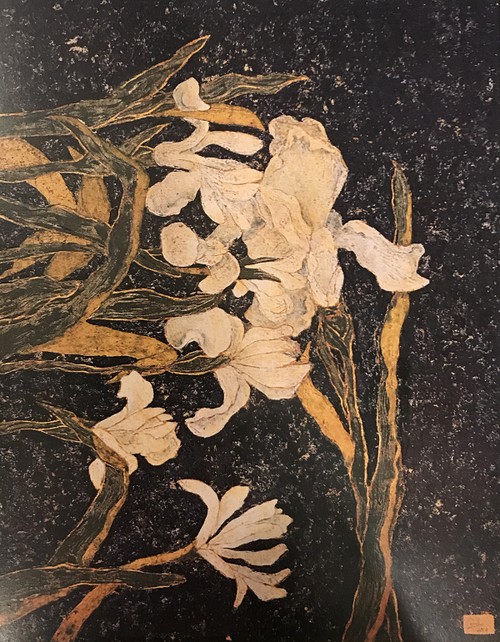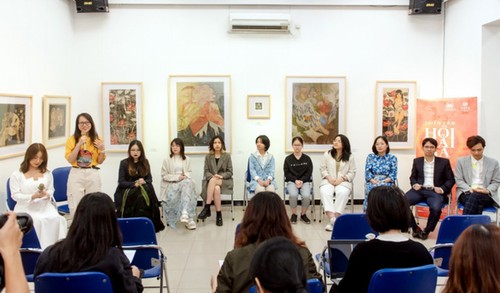 Phuong Anh's lacquer painting Iris 1. (Photo: vnexpress.net) Phuong Anh's lacquer painting Iris 1. (Photo: vnexpress.net) |
Making a lacquer painting is a long, arduous process. It may take months or years, depending on the artists’ technique and how many layers of lacquer are applied.
First, the composition of the painting is drawn with chalk on a board, and white color is added through the use of eggshells. A design is carefully carved on the board. Pieces of clean eggshell are glued to the cavities, and the surface is then made smooth. Clear lacquer is applied and left to dry, and the surface is then polished. Sometimes the artists themselves are amazed at the final results of their work. Ngo Ngoc Phuong Anh has two lacquer paintings entitled Iris 1 and 2 in the exhibition.
"I enjoy making lacquer paintings as I love the feeling of being surprised looking at the final product of my effort. The final product may differ a lot from the beginning expectation depending on the process of making it, especially the polishing step. I can see the eggshells sparkling when I look closer at my paintings. The materials I use in the paintings change their colors a lot after being polished. It looks very beautiful," said Phuong Anh.
It’s not easy for an artist to complete a lacquer painting. Even making the board for the painting is a meticulous process. The core of the board is made from plywood. One layer of lacquer is applied to the plywood and left to dry. Next, a thin cotton cloth soaked in clay is attached to both sides of the plywood. After the cotton/clay mixture dries, the board is smoothed. The process is repeated about 12 times. Layers of black lacquer are then applied and polished. The final product is a very smooth piece of blackboard and is very durable. It should be noted that lacquer is not a harmless substance. Some artists have had to quit making lacquer paintings because of a severe allergy to lacquer.
 GATE's young artists share with the audience their experience in making art works for the Hippocampus exhibition. (Photo: vov.vn) GATE's young artists share with the audience their experience in making art works for the Hippocampus exhibition. (Photo: vov.vn) |
"The most difficult part of making lacquer painting for me is waiting for the colors to dry. Lacquer is mixed with various natural or artificial dyes to produce the colors the artist wants. The smell of the colors is very strong and makes me dizzy and short of breath," young artist Pham Nhat Minh of GATE told VOV.
"Another difficult part is the polishing process, which always gives my hands a lot of cuts and scrapes because the shells of eggs, clams, and snails are quite sharp and hard to polish. I really love Vietnam’s traditional fine arts, and the harder the process is,the prouder I feel when I look at my paintings," said Minh.
Painter Nguyen Duong Hai Dang, a lecturer at GATE, and artist Vu Back Lien of Vietnam’s Fine Arts Association are the tutors who helped GATE’s young artists produce these lacquer paintings.
"Making lacquer paintings requires a lot of patience, determination, and passion for the art. I’m happy that my students all did their best. I find their talent amazing. With such a difficult process, they learned all the techniques very quickly and chose the material wisely," said Hai Dang.
It took GATE’s young artists 2 years to complete their lacquer paintings for the Hippocampus exhibition, which is called “Memories”. While Phuong Anh’s Iris 1 and 2 reflects hope for a better future, Ngoc Minh’s artwork, named after a fruit called Thi or diospyros decandra, shows the artist’s creativity and understanding of Vietnam’s folk tales.